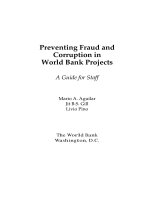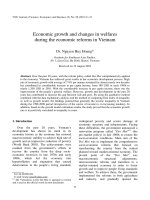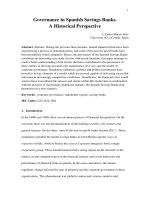Bilbao ubillos (ed ) the economic crisis and governance in the european union; a critical assessment (2014)
Bạn đang xem bản rút gọn của tài liệu. Xem và tải ngay bản đầy đủ của tài liệu tại đây (2.4 MB, 216 trang )
The Economic Crisis and Governance
in the European Union
This book explores the way in which the financial crisis that began in the US
spread to the economy of the European Union. It takes a critical look at the
measures adopted by EU institutions in response to that crisis, seeking to explain
the rationale behind them, their context, their development and why different
exit strategies were not adopted. In doing this, the book makes comparisons with
the measures adopted by institutions in the US and the UK.
As the crisis has shown that the financial supervision frameworks prevailing
in 2007 were not fully able to deal with the largest financial crisis in history, this
volume also reviews the proposals that have been designed to reform the supervisory architecture of financial services in the EU.
The book concludes that the EU member states under most pressure from financial markets do suffer from intrinsic problems, but that the economic effects
of the crisis have been exacerbated by shortcomings in economic governance
within the EU.
This work will be highly relevant to policy makers and scholars looking at
EU integration, finance and market regulation.
Javier Bilbao-Ubillos is Senior Lecturer in the Department of Applied Economics at the University of the Basque Country, Spain.
Routledge studies in the European economy
1 Growth and Crisis in the Spanish Economy, 1940–1993
Sima Lieberman
2 Work and Employment in Europe
A new convergence?
Edited by Peter Cressey and Bryn Jones
3 Trans-European Telecommunication Networks
The challenges for industrial policy
Colin Turner
4 European Union – European Industrial Relations?
Global challenges, national developments and transnational dynamics
Edited by Wolfgang E. Lecher and Hans-Wolfgang Platzer
5 Governance, Industry and Labour Markets in Britain and France
The modernizing state in the mid-twentieth century
Edited by Noel Whiteside and Robert Salais
6 Labour Market Efficiency in the European Union
Employment protection and fixed-term contracts
Klaus Schömann, Ralf Rogowski and Thomas Kruppe
7 The Enlargement of the European Union
Issues and strategies
Edited by Victoria Curzon-Price, Alice Landau and Richard Whitman
8 European Trade Unions
Change and response
Edited by Mike Rigby, Roger Smith and Teresa Lawlor
9 Fiscal Federalism in the European Union
Edited by Amedeo Fossati and Giorgio Panella
10 European Telecommunications Liberalisation
Edited by Kjell A. Eliassen and Marit Sjøvaag
11 Integration and Transition in Europe
The economic geography of interaction
Edited by George Petrakos, Gunther Maier and Grzegorz Gorzelak
12 SMEs and European Integration
Internationalisation strategies
Birgit Hegge
13 Fiscal Federalism and European Economic Integration
Edited by Mark Baimbridge and Philip Whyman
14 Financial Markets in Central and Eastern Europe
Stability and efficiency
Edited by Morten Balling, Frank Lierman and Andy Mullineux
15 Russian Path Dependence
Stefan Hedlund
16 The Impact of European Integration on Regional Structural Change
and Cohesion
Edited by Christiane Krieger-Boden, Edgar Morgenroth and George
Petrakos
17 Macroeconomic Policy in the European Monetary Union
From the old to the new stability and growth pact
Edited by Francesco Farina and Roberto Tamborini
18 Economic Policy Proposals for Germany and Europe
Edited by Ronald Schettkat and Jochem Langkau
19 Competitiveness of New Europe
Papers from the second Lancut economic forum
Edited by Jan Winiecki
20 Deregulation and the Airline Business in Europe
Sean Barrett
21 Beyond Market Access for Economic Development
EU–Africa relations in transition
Edited by Gerrit Faber and Jan Orbie
22 International Trade, Consumer Interests and Reform of the Common
Agricultural Policy
Edited by Susan Mary Senior Nello and Pierpaolo Pierani
23 Economic Governance in the EU
Willem Molle
24 Financial Integration in the European Union
Edited by Roman Matoušek and Daniel Stavárek
25 Europe and the Mediterranean Economy
Edited by Joan Costa-Font
26 The Political Economy of the European Social Model
Philip S. Whyman, Mark J. Baimbridge and Andrew Mullen
27 Gender and the European Labour Market
Edited by Francesca Bettio, Janneke Plantenga and Mark Smith
28 The Economic Crisis and Governance in the European Union
A critical assessment
Edited by Javier Bilbao-Ubillos
The Economic Crisis and
Governance in the European
Union
A critical assessment
Edited by Javier Bilbao-Ubillos
First published 2014
by Routledge
2 Park Square, Milton Park, Abingdon, Oxon OX14 4RN
and by Routledge
711 Third Avenue, New York, NY 10017
Routledge is an imprint of the Taylor & Francis Group, an informa business
© 2014 selection and editorial material, Javier Bilbao-Ubillos; individual
chapters, the contributors
The right of Javier Bilbao-Ubillos to be identified as the author of the
editorial material, and of the authors for their individual chapters, has been
asserted in accordance with sections 77 and 78 of the Copyright, Designs
and Patents Act 1988.
All rights reserved. No part of this book may be reprinted or reproduced or
utilised in any form or by any electronic, mechanical, or other means, now
known or hereafter invented, including photocopying and recording, or in
any information storage or retrieval system, without permission in writing
from the publishers.
Trademark notice: Product or corporate names may be trademarks or
registered trademarks, and are used only for identification and explanation
without intent to infringe.
British Library Cataloguing in Publication Data
A catalogue record for this book is available from the British Library
Library of Congress Cataloging in Publication Data
The economic crisis and governance in the European Union: a critical
assessment / edited by Javier Bilbao-Ubillos.
pages cm
Includes bibliographical references and index.
1. Financial crises–European Union countries. 2. European Union
countries–Economic policy–21st century. 3. European Union countries–
Social policy–21st century. 4. Monetary policy–European Union
countries. I. Bilbao Ubillos, Javier, editor.
HB3722.E2736 2013
337.1'42–dc23
2013019960
ISBN: 978-0-415-85890-8 (hbk)
ISBN: 978-0-203-72303-6 (ebk)
Typeset in Times
by Wearset Ltd, Boldon, Tyne and Wear
Contents
List of figures
List of tables
List of contributors
1
Introduction
ix
xi
xii
1
JAvIER BILBAO-UBILLOS
PART I
Economic crisis in the European Union: roots and
structural weaknesses
2
The great recession and economic policy: roots and
consequences
11
13
XOSé CARLOS ARIAS AND ANTóN COSTAS
3
Financial supervision reform in the EU: a comparison with
the UK and the US
31
ISABEL ARGIMóN, MARÍA LUISA LEYvA AND CRISTINA LUNA
4
The Eurozone, challenging the institutional framework for
economic policy
52
RICARDO ALáEz-ALLER AND CARLOS GIL-CANALETA
5
Why so slow? The crisis and the structural weaknesses of
the EU
MARCO RICCERI
69
viii
Contents
PART II
Praxis of European governance facing the economic crisis:
a critical assessment
6
A critical view of the governance of the crisis in Europe: the
rationales inherent in exit strategies
91
93
JAvIER BILBAO-UBILLOS
7
Questioning the myth of expansive austerity: European
macroeconomic policy during the crisis and its aftermath
114
RAFAEL MUñOz DE BUSTILLO
8
The European sovereign debt crisis and the new
governance: a conservative alternative to European
economic government
134
FRANCISCO RODRÍGUEz-ORTIz
9
Austerity and financial instability
155
ÀNGEL BERGES AND EMILIO ONTIvEROS
References
Index
182
196
Figures
3.1
7.1
7.2
7.3
7.4
9.1
9.2
9.3
9.4
9.5
9.6
9.7
9.8
9.9
9.10
9.11
9.12
9.13
9.14
9.15
9.16
9.17
9.18
9.19
New financial regulatory architecture in the United Kingdom
Real GDP growth in the United States and the euro area
2003–2014 (2012–2014 forecasted)
Average first year multipliers from different types of fiscal
stimulus
Estimate of the impact of fiscal policies on GDP growth for
several European countries, 2011–2012
Forecast GDP growth, different waves: Spain, Greece,
Portugal, Ireland, 2007–2012
Implied bond market volatility in the euro area and the United
States
Euro area sovereign debt yields (ten year bonds)
Probability of any Eurozone country leaving the euro before
end 2013
Fiscal fundamentals at beginning of crisis: ratio of fiscal
primary balance and net government debt to GDP (2009)
Fiscal fundamentals: dynamics since start of crisis
Lending activity in the euro area
Lending activity in the US
Sovereign-financial linkages
Central bank balance sheets
Sovereign debt holdings, by type of investor (in percentage of
total, June 2011)
Change in government spending (dg) and change in GDP
2008: Q1 to 2011: Q1
Austerity and GDP growth 2011–2012
Austerity and increases in debt-to-GDP ratios
Advanced economies: market induced fiscal adjustment
Austerity measures and spreads in 2011
Interest rate growth differential, 2012
Interest payments as a percentage of GDP
Change in spreads vs. initial spreads
Change in debt-to-GDP ratio vs. spreads since 2012: Q2
40
116
126
127
129
155
156
157
159
160
161
161
163
165
166
168
168
169
170
170
171
171
173
173
x
Figures
9.20
9.21
9.22
9.23
9.24
9.25
The euro’s three crises
Banks-sovereign contamination in wholesale markets
Banks-sovereign contamination in retail deposits
Cumulative deposit flows since January 1, 2008
Euro area: target 2 balances
Non-performing loan ratios of euro area large and complex
banking groups (percentage of total loans; maximum,
minimum, interquartile distribution and median)
9.26 Euro area: NFC funding costs
9.27 Spread between interest rates on small and large loans
(January 2006–September 2012; three-month moving
average; basis points)
174
175
176
176
177
178
178
179
Tables
3.1 Financial regulatory and supervisory authorities in the United
States
6.1 Total public revenues per capita in the EU, 2002–2011 (current
euros)
6.2 Total public revenues in the EU as a percentage of GDP,
2002–2011
6.3 Trend in current account balances in some Eurozone countries,
1995–2011 (% of GDP)
6.4 Net international investment position in some Eurozone
countries, 2010 (% of GDP)
6.5 Trend in the Gini Index in selected EU-27 countries,
2008–2011
7.1 Outcome of the fiscal adjustments evaluated by Alesina and
Ardagna
8.1 Trends over time in unit labour costs from 1999 to 2007
9.1 Financial systems: EU vs. US (2010 data)
45
102
102
103
103
112
121
147
162
Contributors
Ricardo Aláez-Aller is Senior Lecturer of Economics at the Public University
of Navarre in Spain. He specializes in wage differences, automotive industry
and economic policy. He has served as Head of the Economics Department at
the Public University of Navarra and he has also lectured at the University of
the Basque Country (Spain), the University of Bordeaux (France) and the
University of Leuven (Belgium).
Isabel Argimón has held the position of Head of the Banking Analysis and Regulatory Policy Division in the Directorate General of Regulation of the Bank
of Spain since July 2007. Previously, she was chief economist of the Public
Sector and Fiscal Policy Unit at the Research Department of the Bank of
Spain, Manager of the economic advisers’ team at the Financial Services
Authority and policy adviser at HM Treasury for public expenditure policy
and financial regulation. She holds a Ph.D. in Economics from the Universidad Complutense of Madrid.
Xosé Carlos Arias is Professor of Economics and Public Policies at the University of vigo (Spain). In recent years he has actively worked in the development of the research program of Transaction Cost Politics. He recently
published the book La torre de la arrogancia. Políticas y mercados después
de la tormenta (Ariel, Barcelona, 2011) jointly with Antón Costas. He also
co-edited Organización de gobiernos y mercados (PUv, valencia). Prominent among their last papers has been, “Transaction Costs Politics in the Map
of the New Institutionalism”, in N. Schofield et al. (eds) Advances in Political
Economy (Springer, Heidelberg, 2013), with G. Caballero.
Àngel Berges and Emilio Ontiveros are professors of Finance and Management at Universidad Autónoma de Madrid, where they have performed teaching and research duties for over 30 years. Additionally, they are the main
partner founders of AFI, one of the largest Spanish consulting companies,
specializing in advisory and consulting services on financial economics and
markets, banking, risk management, as well as high level executive training.
From their twin duties, as academics and consultants, they have developed an
exhaustive and integrated view on the handling of the crisis in Europe.
Contributors
xiii
Javier Bilbao-Ubillos graduated in Economics (University of the Basque Country) and Law (University of Deusto), and obtained his Doctorate in 1990. He
enjoyed a postdoctoral stage at the European University Institute (Florence –
Italy). He currently teaches at the University of the Basque Country (Spain).
He is the author (or co-author) of 22 books and 50 articles in journals such as
European Urban and Regional Studies, Administration & Society, Economic
& Political Weekly, International Journal of Social Welfare, International
Journal of Technology Management, Journal of Economic Policy Reform,
Sustainable Development, Public Money and Management, Social Indicators
Research, and Economic Development Quarterly.
Antón Costas is Professor of Political Economy at the University of Barcelona.
He is interested in the role of ideas and interests in policy formation. He has
published several articles and books on these subjects. His two latest books
are: La torre de la arrogancia. Políticas y mercados después de la tormenta
(Ariel, Barcelona, Barcelona, 2011), jointly with X. C. Arias, and The 2008
Crisis. From Economics to Politics and Beyond (Fundación Cajamar, Almeria,
2010). He is a columnist of El País and other Spanish newspapers.
Carlos Gil-Canaleta is Lecturer of Economics at the Public University of Navarre in Spain. He has made contributions in regional economics and public
administration. He has worked on research programs focused on structural
funds and European policies.
Maria Luisa Leyva has been Senior Economist in the Financial Stability
Department of the Bank of Spain since January 2012. She has developed most
of her professional career in the Bank of Spain, where she has held different
management posts in a wide variety of departments. In particular, she was
head of Division of the Cash Department of the Operations and Payment Systems General Directorate and Head of the European Affairs Division at the
Research Department. She has written about financial institutional frameworks and financial stability. She holds a degree in Economics by the Universidad Complutense de Madrid, Spain.
Cristina Luna has been the Senior Economist at the Financial Stability Department, in the Directorate General of Regulation of the Bank of Spain, since
2002. Previously, she was Senior Economist at the Financial Institutions
Department (1997–2001), in the same Directorate General, and Head of the
Unit of Real Statistics at the Statistical Department in the Directorate General
of Economics, Statistics and Research (1989–1996). She holds a degree in
Economics from the Universidad Autónoma de Madrid, Spain.
Rafael Muñoz de Bustillo is Professor of Applied Economics at the University
of Salamanca. He has written extensively on the labour market, income distribution, the welfare state and European Integration. His latest publications are:
Measuring More than Money. The Social Economics of Job Quality (Edward
Elgar Publishing, Cheltenham, 2011), two chapters in E. Fernández-Macías,
xiv
Contributors
J. Hurley (eds) Transformations of the employment structure in the EU and
US, 1995–2007 (Palgrave, 2012), and a chapter in D. vaugham-Whitehead
(ed.) Work inequalities in crisis. Evidence from Europe (Edward Elgar Publishing, 2011). He is the co-author of a widely used textbook on the EU:
Introducción a la Unión Europea. Una aproximación desde la economía, 4th
edition (Alianza, 2009).
Marco Ricceri is an expert on European social and labour policies, acting as
General Secretary of the research institute EURISPES and as co-founder and
coordinator of the European research group “European Social Model”
(London-Bremen-Rome). He has previously worked at the National Study
Office of the CISL (Free Italian Trade Union) and at the Parliamentary
Groups of the Italian Chamber of Deputies, where he was Chief Officer for
Economic Policies. He teaches at the Link Campus University of Malta in
Rome – Faculty of Political Sciences on the “History of the European Integration Process” and “European Institutions”, and was honored with the
Degree Honoris Causa in European Policies by the Institute of Europe of the
Russian Academy of Sciences (IE-RAS).
Francisco Rodríguez-Ortiz is a Bachelor in Economics (Université Nanterre X,
Paris-France) and holds a Ph.d. in Economics from Université Nancy 2,
France. He is manager of the Department of Economics at the Institute of
European Studies, Universidad de Deusto (Spain), where he is also Professor
of Structure and Economic Policy. An active participant in economic discussions of European economic architecture, he has written many essays in economic and financial publications, and has spoken at dozens of conferences
throughout Spain and France. Recently (late 2012), Rodriguez Ortiz published his sixth standalone book (Las mascaras de la crisis. Europa a la
deriva, Editorial la catarata, Madrid) analysing from an extremely didactic
position, the current and likely future economic backdrop.
1
Introduction
Javier Bilbao-Ubillos
The governance of the economic crisis in Europe has become a topic of
undoubted current interest. There are two main reasons for this:
•
•
On one hand, the economies of Europe are facing a crisis of a magnitude
and complexity not seen for decades: most European Union (EU) Member
Stateshaveslippedbackintorecessioninthefirstquarterof2013without
havingrecoveredfromthemajorshrinkagethattheysufferedin2009.The
effects of the credit crunch can still be felt in matters such as access to
funding1 and problems in the balance-sheets of banks; and what looked like
thecertainbreak-upoftheeurohasbarelybeenavoided,withsomecountries suffering a sovereign debt crisis and Cyprus hovering on the brink of
abandoningthecommoncurrencyinMarch2013.
Ontheotherhand,MemberStateshavebeenunableonthisoccasiontomake
fully autonomous use (at national level) of a number of conventional economic policy instruments that would have helped them to tackle the recession.
These constraints have affected members of the Eurozone in particular (countries which not only have no individual monetary and exchange policies but
havealsolostpartoftheirfreedomtomanagetheirownfiscalpolicies).
Thus,progresstowardsEuropeanintegrationhasmeantthattheMemberStates
oftheEUasawholearehavingtofaceuptotheeconomicandfinancialcrisis
withnopossibilityofresortingtotradepoliciesandwithfiscalpoliciessubject
to a number of constraints that have recently been exacerbated in the formulation
of the new Stability and Growth Pact (SGP) and the entry into force of the
Treaty on Stability, Coordination and Governance (TSCG) for all countries in
the EU-27excepttheUnitedKingdomandtheCzech Republic.But Eurozone
members no longer have the option of resorting to changing their exchange rates
and interest rates (methods that have traditionally proved useful in economies
suffering from asymmetric shocks).
Untilnow,theconsequencesofhandingoverauthorityforeconomicpolicy
to supranational EU bodies had never been tested under adverse circumstances.
Inthissense,thecurrentcrisishasposedanenormouschallengetothearchitecture of economic governance designed in the EU, which seems not to have
2 J. Bilbao-Ubillos
worked as dynamically or effectively as necessary: hence the topicality and
interest of the study undertaken in this book.
Withthisinmind,thebookisdividedintotwomainparts:
•
•
PartIfocusesontherootsandstructuralweaknessesthathaveprovedconducive tothepropagationand,aboveall,durationoftheeconomiccrisisinthe
EuropeanUnion,whereitsimpacthasbeenfeltforlongerthaninotherinstitutional contexts. Some of the elements that sparked the current situation can be
found in the very institutional design and construction of European Monetary
Union(EMU).TheauthorsoftheDelorsReportof1989(whichprovidedthe
basis for the drawing up of the Treaty of European Union in those points concerned with EMU) were aware that the future monetary union could not be providedwithamechanismforthetransferofpublicresources,andthatitwould
be difficult to achieve enough labour mobility and price/wage flexibility to
tackleanasymmetricshock(Garcia-DuránandMillet2012:114).Aspointed
out by Bergsten (2012: 110), Europe embarked on a broad, but incomplete,
processofmonetaryunionbackedbytheeuroandtheEuropeanCentralBank
(ECB);buttheprocessincludedpracticallynoeconomicunion(e.g.nofiscalor
banking union), no institutions for sharing economic governance and no
effectiveco-ordinationofstructuraleconomicpolicies.Butbesidesthis,PartI
analysesspecificallythemodelofeconomicgrowthoftheprecedingdecades,
thedifferentfinancialsupervisionarchitectures,theinstitutionalframeworkof
theEurozoneintermsofattainingshort-termmacroeconomicpolicyobjectives,
and the way in which decision-making processes are regulated.
PartIIexaminesthepraxisofeconomicgovernanceasactuallycarriedout
intheEUduringthemanagementoftheeconomiccrisis,andtakesacritical
look at the dysfunctions that have led to its disappointing economic results.
To that end it looks at the economic policy guidelines that have prevailed in
thestrategiesdrawnupforexitingthecrisis,attheeffectivenessofthedecisions made by the EU and at the way in which the debt and banking crises
have been handled. It also examines what some authors have called “conflicts between national interests” (Comín 2012: 37): it is argued that such
conflicts may have given rise to asymmetries in the capacity for political
influence in joint decision-making and in the possibility of adapting the
“rulesofplay”totheneedsofeachcountry.
The chapters that make up the two parts have been put together as follows: Part
I,whichisclearlyfocusedonthehistoricaldevelopmentoftheprocessofEuropeanintegration,looksmainlyatinstitutionalpointsandatmattersofcontextin
the formulation of economic policies, including the distribution of authority
amongCommunitybodiesandnationalinstitutions.Accordingly,thefourchapters in Part I are set out as follows:
•
Chapter2analysesthemodelofeconomicgrowthoftheprecedingdecades,
paying particular attention to the changes made in the theories of economic
Introduction 3
•
•
•
policy and the lesser degree of freedom that results from the formidable
external restrictions imposed by ever more voluminous and internationalised
financialmarkets,whichmakeitharderformanycountriestodrawupmore
autonomous policies.
Someauthorsarguethat,inthecontextoftheeconomicandsocialprospectsenvisionedforthenextdecade,therearepowerfulreasonsthatpoint
towardsacertainreturntotheideaofactive,changingmacroeconomicpolicies. That is tosay,public and marketpolicies should advancetowards a
new,morestablebalance.Thiswillrequiregreaterautonomyforpolicyand
the reintroduction of pragmatic controls on transnational movements of
capital. Should this not be done, it is very likely that the international
economywillfacefurther,highlyseriouscrises.
Chapter3reviewsthedifferentarrangementsinplaceforthesupervisionof
thefinancialsectorandtheproposalsforreformingthisarchitectureofthe
supervisionputforwardfrom2007onwardsinsomecountries;itcompares
andassesseshowwelltheyaresuitedtotheneedsidentifiedintherelevant
jurisdictions. The European Banking Union (with the initial launch of the
SingleSupervisionMechanism),theabolitionofthesinglesupervisorinthe
UK and its replacement by a twin peak supervision model and the Dodd-
FrankAct(whichimplementsregulatoryandsupervisoryreformintheUS)
are described and analysed. Progress in the area of financial stability has
been generalised as evidenced by the changes introduced in the three jurisdictions, which have provided financial authorities with instruments to
develop a macro-prudential policy.
Chapter 4 analyses the shortcomings in the institutional framework of the
Eurozone in terms of attaining short-term macroeconomic policy objectives.
Special attention is paid to the distribution of areas of authority between
national governments and supranational bodies in matters of monetary
policy, control of fiscal policy instruments, supervision of the financial
system and management of government debt.
Finally,Chapter5looksatthestructurallimitsofeconomicgovernancein
theEU,focusingprimarilyonthewayinwhichdecision-makingprocesses
areregulated,whichhamperstheearlydiagnosisofproblemsandprevents
sufficientlyfastandflexibleresponsesfrombeingmade.Itisarguedthatthe
seriousness of the crisis, combined with the economic and demographic
prospects,willforcearethinkingoftheconditionsforthepursuitofprofit
andleadtoprogresstowardsanew,sustainableconceptofdevelopmentand
a reorganisation of the welfare state.
Part II takes a critical look at the response strategy implemented by the EU in
managingtheeconomiccrisis,andseekstoexposetheshortcomingsintermsof
governance and the dysfunctions inherent in the measures taken (and in the
failuretotakeothers),whichhaveexacerbatedtheproblemsandfurtheredalack
of confidence among financial operators. The chapters look first at general
aspects (the drawing up of exit strategies in the governance of the crisis in
4 J. Bilbao-Ubillos
Europe,theeconomicpolicybenchmarksthathaveguideddecision-makingand
theconsequencesoftheactionstakenintermsofeconomicpolicy)andthenat
morespecificpoints,i.e.pointswhicharehighlyimportantbutwhichaffectspecificaspectsofeconomicintervention(suchasthewayinwhichsovereigndebt
crises have been treated).
These chapters are structured as follows:
•
•
Chapter6startsfromthepremisethattherewerestructuralshortcomingsin
the design of the Eurozone (comprising as it did countries with widely differing fabrics of production and levels of competitiveness that did not constitute an optimum monetary area) and then sets out a reasoned argument
asserting that the architecture of economic governance in the EU has serious
failings in its ideological aspects (design of a coherent exit strategy) and in
its institutional aspects (procedures, irreversibility and implementation
periods of the decisions made).
Asaresult,theEU’sresponsetothecrisishasbeenlateincoming,hesitantandsometimeslackinginsufficientforce.Therehavealsobeencontradictorymeasurestakenoverthecourseofthemanagementofthecrisis,as
evidenced in the brusque changes of exit strategy and the low level of
observanceofsomeofthedecisionsmadebytheEU(e.g.thefirstbail-out
agreementforCyprusdeliberatelycontravenedDirective2009/14/CEofthe
EuropeanParliamentandtheCouncilof11March2009,whichguaranteed
deposits up to €100,000 and was transposed into the legislation of the
variousMemberStates;moreover,itenvisagedtheenforcementofcontrols
onmovementofcapital,amovewhichwashighlyexceptionalintermsof
EU regulations).
Thus,theintrinsicproblemsofsomeMemberStates(strongbudgetaryor
external trade imbalances, vulnerable financial systems, economic stagnation and poor labour market operation) have been exacerbated by the lack of
confidence shown by the markets in the operation of the euro and in EU
institutions as a whole.
Chapter7givesaninterpretationofthesuccessivemeasuresadoptedfrom
the viewpoint of the economic policy paradigms that have served as benchmarksforthem.Atthestartoftheeconomiccrisisin2008,mostEUgovernments (and the European Commission) embraced what could be
consideredasthestandardKeynesianeconomicresponse,albeitwithdifferentlevelsofenthusiasm.Twoyearslatertherewasageneral,radicalU-turn,
whichplacedfiscalconsolidationattheforefrontofeconomicpolicy.
Althoughthischangecanbepartlyexplainedbytheincreasingpressure
exertedbythefinancialmarketsontheweakestcountries,therewasageneral
beliefatthetime(thatstillpersiststoday)thatfiscalconsolidationcouldlead,
even in the short run, to economic growth. The chapter reviews the likelihoodofsuchaneventfromtheoreticalandempiricalperspectives,thehypothesis of expansive austerity and the implications of the adoption of such an
interpretation of the functioning of markets for the recovery of the EU.
Introduction 5
•
•
Chapter8,writtenfromapoliticaleconomyviewpoint,warnsofthepossibility that governments may seek to break the deficit/debt circle by further
loweringworkingconditions,salariesandsocialwelfareconditions,whose
detrimental effects on growth can no longer be counteracted by borrowing.
RatherthanoptingforafederalisationofEuropeaneconomicpolicy,which
would take into account the interests of the different states and create mechanisms for solidarity, the exit strategy implemented seems to consist of
imposing new rules of governance that tilt the balance of power further
towards the market and away from the state. These new rules of governance
comprisea“EuropisationofconservativeGermanpolicies”.
Chapter9focusesonthemanagementofthesovereigndebtcrisesandseeks
toexplainthebehaviourofthefinancialmarkets,basedontheirassessment
of the economic situation of each country and the potential for getting back
to the path to growth.
At the beginning of the crisis, Spain had a much lower level of public
debtthanmostEMUcountries;less,indeed,thantheUK,theUSandJapan.
Infact,eventodayitspublicdebtisbelowtheaverageforOECD(OrganizationforEconomicCooperationandDevelopment)countries,yetSpainis
one of the countries whose public debt has been penalised most by the
markets. The reason is the high level of private debt in Spain, the great
majorityofwhichisintermediatedthroughthebankingsystem.Aslongas
doubtsremainconcerningthehealthoftheSpanishbankingsystem,markets
will be increasingly worried that some of that private debt might eventually
be converted into public debt.
Thisrepresentsa“diabolicalloop”thatismagnifiedbythesingle-minded
approach that is currently being imposed to correct the imbalances within the
Eurozone. According to this view, all adjustments should rely on austerity
measures taken by debtor countries. The present book argues that, far from
helping to correct those imbalances, over-reliance on austerity measures
deepens the vulnerability of the Spanish banking system and therefore threatensthelong-termeconomicpotentialandsustainabilityofpublicfinances.
The critical tone employed here should be seen as an invitation to hold a broad
discussion in academic circles and indeed among decision-makers concerning
thevariousoptionsforfindinganexitfromthecrisis,andtheconsequencesof
eachoneintermsofgrowth,employment,financialstability,socialandterritorial cohesion and support for the European project. Some theoretical benchmarks
orienting exit strategies from the crisis in Europe that have prevailed in the face
ofalltheempiricalevidenceneedtobecalledintoquestion,notjustbecauseof
the poor results that they have attained to date but also because of the scant
attentionthathasbeenpaidtoothermoreambitious,firmermeasurestakenelsewhere(e.g.intheUS,theUKand,morerecently,Japan),andbecauseoftheir
negativeconsequencesintermsofthefeelingofbelongingtotheEUinvarious
countries (there has been an alarming upsurge in euro-scepticism in many
countries).
6 J. Bilbao-Ubillos
The constraints imposed on the ECB by basic Community regulations have
forcedittofocusonpricestabilityasitssoleobjective(Art.127oftheTreatyon
the Functioning of the European Union – TFEU) – set and obsessively held at a
mysticalfigureof2percent2 – and prohibited it from providing direct funding to
public sectors (Art. 123–124 TFEU). For a long time this has theoretically
deprived the ECB of any significant capability to intervene on a discretional
basis in support of the liquidity of financial systems, the solvency of governments or the soundness of the euro (thus discouraging speculation), given that
interestratesarenowsolowthatother,lessorthodoxwaysofstimulatinggrowth
from monetary policy must be found.
In its Global Financial Stability Report, published in April 2013 (IMF
2013a), the IMF (International Monetary Fund) refers to the combination of
exceptionally low policy interest rates and unconventional policy measures as
“MP-plus” to indicate that these policies go beyond conventional monetary
policy in terms of tools and objectives. The IMF classifies these measures –
whichhavebeenimplementedbyseveralmajorcentralbanks,butespeciallyby
theFederalReserve,theBankofEnglandand,morerecently,theBankofJapan
– into four groups:
1
2
3
4
prolonged periods of very low interest rates, sometimes combined with
forward guidance on the length of time for which rates are expected to
remain low;
quantitative easing (QE), which involves direct purchases in government
bond markets to reduce yield levels or term spreads when the policy rate is
at,orcloseto,thelowerbound;
indirect credit easing (ICE), in which central banks provide long-term
liquiditytobanks(sometimeswitharelaxationinaccessconditions),with
the objective of promoting bank lending; and
direct credit easing (DCE),whencentralbanksdirectlyinterveneincredit
markets – such as through purchases of corporate bonds or mortgage-backed
securities –tolowerinterestratesand easefinancing conditions (and possibly mitigate dysfunction) in these markets.
Up to the end of 2011 (two waves of euro “quantitative easing” by December
2011andFebruary2012),theECBdidnottakepartinthisintensive,proactive
useofmonetarypolicy,andindeeditcontinuestoexpressreservationsconcerningsomemeasures.Thisisespeciallytruefortheacquisitionofsovereigndebt
(the announcement of outright monetary transactionsbytheECB–insecondary,sovereignbondmarkets,undercertainconditions,3 involving bonds issued
byEurozoneMemberStates–wasmadeon2August2012andconcretisedby
September).Moreover,theECBistosteriliseallitspurchasessothatitsprice
stability objective is not affected.
The treaties also sanction the prohibition on any country answering for the
debtsandfinancialobligationsofanotherMemberState(Art.125TFEU),which
has formally prevented any mutualisation of sovereign debt and any extraordinary
Introduction 7
provision of resources to draw up a truly compensatory budget at the European
level that might have been able to mitigate at an early stage the economic problemsofcountriesthathavesubsequentlyhadtobebailedout.
ThevestedinterestsofsomeMemberStates(e.g.Germany,theNetherlands
and Finland) in defending a literal interpretation of the treaties and intergovernmentalagreementshaspreventedtheattainmentevenoftheminimalflexibility
that would have enabled the aforesaid solutions to be implemented as alternatives to the rigid official position. That official position has begun to change
only very gradually since the risk of the break-up of the euro and of insolvency
on the part of governments and financial systems has become evident (i.e. as
fromMay2010).
These constraints and self-imposed limitations have shaped the ideological
componentofeconomicgovernanceofthecrisisintheEU,withtheemphasis
beingonausterityinthepublicsectorandfullconfidenceintheefficientworking
of the markets, especially the financial markets. In the terms used by Susan
Strange,thisblock,headedbyGermany,couldbesaidtohaveexertedstructural
power in the EU, in thatit has been capable of dominating theworld of ideas
and imposing a hegemonic interpretation of events that is not open to argument.
It thus indirectly determines what economic policy decisions are made and what
prioritiesarediscussed(Steinberg2013).
DeGrauweandJi(2013:2)rightlydescribethelogicbehindthisdominant
approach as follows:
(...)thesurgingspreadsobservedfrom2010tothemiddleof2012werethe
resultofdeterioratingfundamentals(e.g.domesticgovernmentdebt,external debt, competitiveness, etc.). Thus, the market was just a messenger of
bad news. Its judgement should then be respected. The implication of that
theory is that the only way these spreads can go down is by improving the
fundamentals,mainlybyausterityprogramsaimedatreducinggovernment
budgetdeficitsanddebts.
However,asthe same authors pointout, when inSeptember2012 the ECB
finallyfoundthewilltoact4–followingtheannouncementbyDraghionJuly26
that “the ECB will do what’s needed to preserve euro” – spreads decreased
sharply. It can therefore also be argued that had it acted earlier, much of the
panic in the markets may not have occurred and excessive austerity programmes
may have been avoided. As stated by Begg, “where individual Member States
have no option but to consolidate public finances, there is a danger of a collectivedeflationarybias”(Begg2012:4).
Nor should it be forgotten that the austerity programmes prescribed for the
public sectors of Member States with sovereign debt problems coincided with a
tendency towards deleveraging among businesses and households in those same
states, and with a strong euro on the currency markets (with the EU failing to
react to movements by the bigger countries in pursuit of more favourable
exchange rates that would lead to an upturn in demand through exports). It is
8 J. Bilbao-Ubillos
preciselyinthiscontextthatBegg’swarningoftheriskofdeflationtakesonits
full meaning, especially since those EU countries that could have found more
room for manoeuvre in budgetary terms (because they were close to balancing
their public-sector accounts or because their debt levels were increasing more
slowly) failed to act as drivers to activate economic recovery throughout the area
andrefusedtoimplementfiscalstimulusprogrammes.
Finally,theEUalsofailedeffectivelytocombattaxavoidance(theeffectsof
whichhavebeenfeltmostinsouthernEuropeancountries,wheretaxablebases
have decreased steadily) or to make real progress in dealing with tax havens,
banking secrecy and harmful tax competition.
If these failures are considered jointly (explained implicitly or explicitly by
the ideological standpoint of economic governance as implemented to date) it
canbeseenwhytheEUistheareathatisfindingithardesttoemergefromthe
crisis,theareathattheIMFconsiderstobeatmostriskoffinancialinstability
andtheareawherethepolarisation(core/periphery)ofeconomiesisgreatest.
However,asarguedinvariouschaptersofthisbook,itisnotonlytheideologicalaspectofgovernancethatmustbequestioned:theinstitutionalororganisational component of European economic government must also be revised in
anattempttoincreaseitsspeed,consistencyandefficiencyindecision-making,
and in pursuit of a clearer, more legitimate leadership of Europe with rules of
play based on accountability and the assumption of responsibility. Tardiness in
reachingacommondiagnosisoftheproblemsfaced,delaysinimplementingthe
decisionsmadeandfrequentchangesofplan,havepreventedeffectiveresponses
from being made to the challenges posed.
Tosumup,whatisurgentlyneedednowisahigherlevelofpoliticalandeconomicintegrationtosupporttheeuro,assuringthesolvencyofthepublicsectors
andfinancialsystemsofMemberStatesand,atthesametime,ensuringajoint
visionofEurope’sproblemsinthemediumandlongtermthatlooksbeyondthe
interests of individual governments (conditioned by electoral calendars and
publicopinion).TheeconomiesofEuropearecloselyinterlinked,andtheproblems of one country inevitably end up affecting the rest5 through foreign trade or
throughtheireffectsonconfidenceintheeuro,thebalanceofincomeandmovements of capital.
This perspective must not be lost by subjecting it to “moral hazard” considerations and game theory or by trusting exclusively in the working of the
markets.Iftherateoffiscalconsolidationinthemostvulnerableeconomiesis
notadjustedtothegradualrecoveryofdemandinEuropeandindeedworldwide,
and if measures to stimulate recovery are not taken at the same time, then the
riskofalong-lastingrecession,orevenofdeflation,willbeveryreal.AsDarvas,
Pisani-FerryandWolff(BruegelInstitute)conclude:
TheEuropeanUnion’sweaklong-termgrowthpotentialandunsatisfactory
recoveryfromthecrisisrepresentamajorpolicychallenge.Overandabove
thestructuralreformagenda,whichisvitallyimportant, bold policy action
is needed.Thepriorityistogetbankcreditgoing.Bankingproblemsneed
Introduction 9
to be assessed properly and bank resolution and recapitalisation should be
pursued.Second,fosteringthereallocationoffactorstothemostproductive
firms and the sectors that contribute to aggregate rebalancing is vital.
Addressing intra-euro area competitiveness divergence is essential to
support growth in southern Europe. Third, the speed of fiscal adjustment
needs to be appropriate and EU funds should be front loaded to countries in
deep recession, while the European Investment Bank should increase
investment.
(Darvas,Pisani-FerryandWolff2013:1,myemphasis)
Notes
1 The Commission itself mentions “inefficiencies in the intermediation chain” in its
Working Document Accompanying the Document/Green Paper “Long-term Financing
of the European Economy”(EuropeanCommission2013a:12).
2 Referringtothewayinwhichmonetarypolicyshouldbeconductedinanon-optimal
currencyarea,Palleywarnedasearlyas2003thathigherinflationwouldberequiredto
avoidhigherunemployment(Palley2003:98).
3 MainlythesigningbeforehandofaMemorandumofUnderstanding(MoU)withstrict
conditions with the issuing country, in which the ECB always maintains a get-out
optionincasetheMemberStateisobservednottomeetitscommitments,sothatthe
programme is cancelled.
4 On September 6, 2012 the ECB agreed to start up a new, potentially unlimited programmeofsovereigndebtpurchases(onthesecondarymarket,forbondsuptothree
years)withaviewtoreducingthehighfinancingcostsoftroubledEurozonecountries
and putting a stop to the debt crisis.
5 In its Spring 2103 report on the global situation, the International Monetary Fund
(IMF)confirmsthatthecrisislocatedintheEurozoneperipherycountrieshasspreadto
thecore,andforecastsa0.3percentcontractionofGDP(grossdomesticproduct)in
theEurozone(IMF2013a).
This page intentionally left blank









